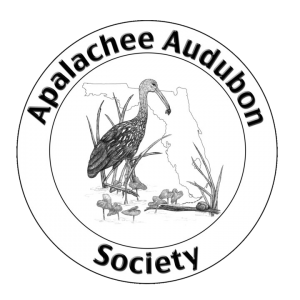By Peter Kleinhenz
A great egret perches on the edge of the Wacissa River at the Aucilla WMA bioblitz. Photo by Emily Ellis.
What the heck is a bioblitz? A bioblitz consists of various teams made up of members of the public going out with taxonomic group experts to search for as much life as possible, within a set geographic area, within a set period of time. On May 6, the Florida Fish and Wildlife Conservation Commission held just such a blitz at Aucilla Wildlife Management Area in Jefferson County.
Groups searched for birds, plants, reptiles/amphibians, and insects. The bird group was led by Apalachee Audubon members Budd Titlow, Don Morrow, Rob Williams, and Dana Bryant. They were joined by Scott Davis, a St. Marks National Wildlife Refuge ranger, who assisted with plant identification.
Bioblitz participants check out a butterfly captured by butterfly expert, Dean Jue, at the Aucilla WMA bioblitz. Photo by Andy Wraithmell
33 participants, ranging from 9-year-olds to grandparents, trekked on trails, forest roads, and through the forest in search of life. Each team surveyed for all taxonomic groups and had the opportunity to visit three different natural communities. Groups checked traps for turtles and cave invertebrates, paddled down the Wacissa River in search of birds, and netted butterflies feeding on roadside flowers. Life (including ticks) abounded.
Participants cataloged their finds using iNaturalist, as part of the Florida Nature Trackers program. This data will ultimately be shared with FWC biologists and the Florida Natural Areas Inventory in order for them to better understand, and conserve, the life found on the area.
Below is a list of the birds observed that day:
- Wood Duck
- Wild Turkey
- Great Egret
- Cattle Egret
- Little Blue Heron
- Black-crowned Night-Heron
- Turkey Vulture
- Swallow-tailed Kite
- Mississippi Kite
- Red-shouldered Hawk
- Common Gallinule
- Limpkin
- Spotted Sandpiper
- Common Ground-Dove
- Mourning Dove
- Yellow-billed Cuckoo
- Barred Owl
- Common Nighthawk
- Ruby-throated Hummingbird
- Red-bellied Woodpecker
- Downy Woodpecker
- Pileated Woodpecker
- Acadian Flycatcher
- Great Crested Flycatcher
- White-eyed Vireo
- Yellow-throated Vireo
- Red-eyed Vireo
- American Crow
- Fish Crow
- Northern Rough-winged Swallow
- Barn Swallow
- Purple Martin
- Carolina Chickadee
- Tufted Titmouse
- Carolina Wren
- Blue-gray Gnatcatcher
- Swainson’s Thrush
- Brown Thrasher
- Black-and-white Warbler
- Prothonotary Warbler
- Swainson’s Warbler
- Hooded Warbler
- Northern Parula
- Pine Warbler
- Yellow-throated Warbler
- Eastern Towhee
- Summer Tanager
- Northern Cardinal











